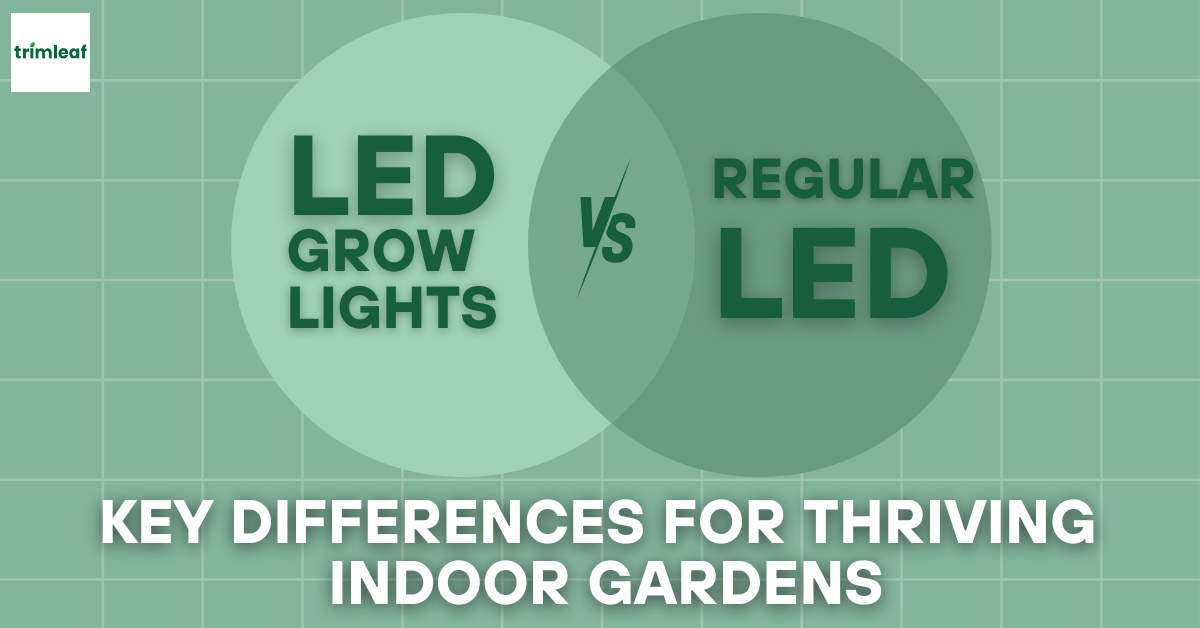
Some indoor gardeners think that LED lights bought from your hardware store are enough for plants indoors.
After all, they do come in different hues, from white to natural light, which is similar to a typical sunny day.
But truth be told, those LED bulbs are not enough to maintain plants. At most, they will just maintain their size, assuming they don’t wilt. If you’re looking for your plants to thrive, then a dedicated LED grow light is a better option.
LED grow lights present clear advantages for supporting healthy, robust plant growth. By understanding how they stand out from the typical consumer-grade LED bulbs, you can make more informed decisions to maximize your indoor plants' potential.
Table of Contents
How Plants Use Light to Grow

Plants rely on light for one of their most essential processes: photosynthesis.
Photosynthesis is the process by which plants convert light, carbon dioxide, and water into energy, which is stored as glucose. The stored energy is used to stimulate growth and the production of fruits and flowers.
Without sufficient lighting, photosynthesis slows down, leading to stunted growth and weakened plants.

-
Blue light is crucial during the vegetative stage. It is responsible for stronger roots and healthy leaves.
- Red light is critical for flower and fruit development, which encourages plants to bloom.
Without the right lighting spectrum, plants will struggle to grow and may not reach their full potential. That is why specialized LED grow lights were developed to address the needs of indoor growers looking for an efficient way to grow plants without access to natural sunlight.
Understanding Regular LED Lights

Regular LED lights are common in homes and offices for general lighting needs. They are energy efficient and have replaced the traditional incandescent and fluorescent bulbs.
However, they are insufficient when it comes to indoor growing. They might have certain spectrums to produce lighting that’s similar to natural sunlight, but they lack the red and blue wavelengths needed for photosynthesis.
As a result, plants might be able to survive under regular LED lights, but they are unlikely to thrive, due to the absence of the needed spectrum for photosynthesis.
Over time, they will exhibit symptoms of insufficient lighting, such as leggy stems and slow flower and fruit development.
Understanding LED Grow Lights

LED grow lights are made specifically to meet the needs of plants by providing the ideal light spectrum and intensity needed for growth. Unlike regular LED lights, which are designed for general lighting, LED grow lights help in photosynthesis and plant development in all stages.
What makes grow lights stand out is the spectrum they emit. LED grow lights are tweaked to deliver red and blue wavelengths of the spectrum, which is critical in photosynthesis.
In some cases, these LED grow lights are also tuned to deliver UV lighting, which is also critical to plant growth.
There are also LED grow lights that offer full-spectrum coverage, adding spectrums that make it closer to natural sunlight.
The Differences between Regular LED Lighting and LED Grow Lights
The most notable difference between regular LED lighting and LED Grow Lights is the spectrum. But there are other advantages LED grow lights offer that make regular LED lighting insufficient.
Light Intensity
LED grow lights deliver a stronger intensity compared to regular LED lights. This light intensity is critical to ensure that photosynthesis kicks in.
While regular LED lights can get intense, it’s not designed for long-term plant growth and can cause challenges in producing energy to grow.
Energy Efficiency
While both regular and LED grow lights are energy efficient, LED grow lights focuses their energy output on the spectrums needed for plants.
This targeted approach ensures that the energy used is effective for plant growth.
Longevity for Plant Growth
LED grow lights are more durable than regular LED lights, due to the environment they were designed for. They feature dust and water seals ensuring their longevity, as indoor garden setups are likely to have soil and water particulates abound.
Are LED Grow Lights Worth the Investment?
No doubt that regular LED lights might seem to be a more practical option due to the cost. But if you are serious about growing indoors, with the end goal of cultivating, LED grow lights are a better choice.
Considering the benefits, your plants are likely to survive and thrive better. While the cost of LED grow lights is higher than regular LED lights, the benefits outweigh the costs. You are assured of better results and a bountiful harvest.
For anyone serious about indoor gardening, the long-term benefits and savings make LED grow lights a worthwhile investment that pays off over time.
Parting Thoughts
If you are thinking of setting up an indoor garden, you are better off using LED grow lights. Regular LED lights are lacking in spectrum and you just might end up wasting effort in growing, due to the deficiencies regular LED lighting has.
Consider making a proper investment in LED grow lights if you are serious about indoor growing. The benefits these lights offer will ensure that your plants will thrive. Ready to buy your LED grow light? Read here to learn more:
- LED Grow Lights: A Comprehensive Buyer's Guide
- Best LED Grow Lights (2024)
- The Best 4x4 LED Grow Lights
- Grow Lights: How Many Watts Per Plant/Square Foot is Needed?
- All About Grow Lights for Indoor Plants
- Growing Indoors? Here Are The Best Grow Light Setups to Consider
- Time to Shine: Understanding Grow Light Schedule for Optimal Growth
Frequently Asked Questions About LED Grow Lights vs. Regular LEDs
- What is the primary function of LED grow lights in indoor gardening?
- LED grow lights provide the ideal light spectrum and intensity needed for plant growth, supporting photosynthesis and development.
- How do LED grow lights differ from regular LED bulbs in terms of light spectrum?
- LED grow lights emit red and blue wavelengths, which are crucial for photosynthesis, while regular LED bulbs lack these specific wavelengths.
- What role do UV wavelengths play in plant growth, and do LED grow lights emit them?
- UV light is essential for plant growth, and some LED grow lights are designed to emit it.
- Can you explain the concept of "full-spectrum" LED grow lights?
- Full-spectrum LED grow lights emit a broader range of wavelengths, making the light closer to natural sunlight.
- How do LED grow lights compare to regular LED bulbs in terms of light intensity?
- LED grow lights deliver a stronger intensity, ensuring efficient photosynthesis.
- Are LED grow lights more energy-efficient than regular LED bulbs?
- Yes, LED grow lights focus their energy output on the wavelengths needed for plants, making them more energy-efficient.
- Why are LED grow lights considered more durable than regular LED bulbs for indoor gardening?
- LED grow lights are designed for indoor environments with potential exposure to soil and water, featuring dust and water seals for longevity.
- Are LED grow lights a worthwhile investment for serious indoor gardeners?
- Yes, while LED grow lights have a higher initial cost, the long-term benefits and potential savings outweigh the expenses.
- What factors should be considered when choosing an LED grow light for indoor gardening?
- Factors to consider include light spectrum, intensity, coverage area, and energy efficiency.
- Can LED grow lights be used to grow a variety of plants, or are they more suitable for specific types?
- LED grow lights can be used to grow a wide range of plants, as they provide the essential light for photosynthesis. However, different plants may have specific lighting requirements.




